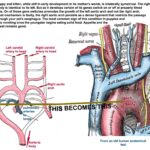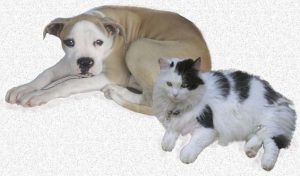Why Is My Dog Or Cat Vomiting?
Ron Hines DVM PhD
 Gagging and coughing can look quite similar in cats
Gagging and coughing can look quite similar in cats
 The Aortic Arch Problem In Dogs
The Aortic Arch Problem In Dogs
Coming home from work only to find a mess on the floor is a common reason owners take their pets to see the vet. When your pet is a dog, the most common cause for that are dietary “indiscretions” – pets that found the leftovers of yesterday’s supper, or who shared a midnight snack with their owner. When your pet is a long-haired cat, the most common cause are fur balls.Veterinarians dispense considerably more pain-relief medications than they once did. These are usually non-steroidal anti-inflammatory compounds or NSAIDs, medications like Rimadyl®, Metacam®, Previcox® and their generic equivalents. When side effects occur in your pet, the most common ones are digestive system irritation and vomiting. The same effect is even more likely to occur if you give your pet medications designed for humans (like aspirin). All are always unsafe when given repeatedly to cats. Stop those medications and call your veterinarian if side effects occur. You can read more about NSAIDs and their effects in an article of mine on arthritis in older dog here or one on pain management here, or about what other veterinarians occasionally confront due to medications here.
Anything that irritates your pets’ stomach or produces nausea will cause your pet to vomit – just as people do. Dogs and cats have better developed vomit (emesis) reflex than we do. Dogs, in particular, have a very easy vomit reflex – probably to protect them when they have eaten spoiled or contaminated foods. Cats did not need that because their prey were living rodents.
Vomiting, like fever, has a myriad of causes. Sometimes it is a rather straightforward project for your veterinarian to decide why your pet vomited, but it can also be quite difficult. The most important factor determining if this is a minor problem or a sign of a more serious health issue are other signs that accompany vomiting. Things like frequency of the problem, weight loss, changes in energy level, bowel and bladder habits or evidence of pain and distress.
Veterinarians are always happy when owners actually bring in a sample of the material their pet barfed up. Many owners can’t bear to do this, but the material vomited is often the clearest clue as to the cause. Sometimes, it is also easier for your veterinarian to distinguish between vomit and the mucus remnants of stool that accompanies colitis and diarrhea. Aluminum foil, leaves, bone fragments, Christmas tree tinsel around the holidays, bits and pieces of favorite toys and swallowed fast food containers are high on the list of things found in vomit that ought not be there. Many of these items will later appear in the pet’s stool.
Vomited material that is high in mucus or that contains blood, usually indicate that the pet’s stomach or high intestine is inflamed and ulcerated. Undigested food can indicate tainted food, anxiety, or simply over eating. Bile and mucus are often present when the source of irritation is in the upper small intestine (duodenum). That is the area of the intestines where bile enters. When that area of the intestine is inflamed, the direction of intestinal contractions are reversed (back toward the stomach) and vomiting is very common. (reverse peristalsis). That is the reason we occasionally see intestinal worms (roundworms) in vomit.
When problems originate lower down the intestine, the blood is usually more digested (caramelized) and the odor of the material is more intense and suggestive of stool. Another important clue to the area of inflammation is the length of time between the vomiting episode and the pet’s last meal. Vomiting is usually most rapid when it is the actual stomach lining that is inflamed. Blockages or inflammation of the esophagus is the most rapid. When that occurs, the food is disgorged in sausage-like segments.
Vomiting accompanied by fever (or abnormally low body temperature), bloody diarrhea, weakness or respiratory distress is always an emergency situation. Those pets need to be taken to your veterinarian immediately. The same thing applies to vomiting that continues throughout the day. Repeat vomission, also depletes the pet’s body of acid, causing metabolic alkalosis and depletes the pet’s body’s potassium stores. When the pet also has diarrhea or cannot keep water down, they rapidly dehydrate. All three events will lead to muscular weakness.
Here are some of the common causes of vomiting that come to mind:
Causes Associated With Things Your Pet Ate:
Dietary Indiscretions:
The most common cause of vomiting in dogs (not so in cats) is dietary indiscretions – the eating of trash, grass, plant leaves, etc. It is amazing the things some pets will eat! Many of these incidents are actually separation anxiety cases where a panicky pet eats everything in sight. You can read more about separation anxiety here. Placing these pets (dogs and cats) on a large dose of petrolatum-based cat laxative is often all that is required to slide this material out with the stool. But these pet need to be monitored continuously for seventy-two hours to be sure their intestines do not block or perforate. At the first sign of abdominal distress, depression, general weakness, fever or blood in vomitus or stool, they should be rushed to a veterinarian for further evaluation.
If you give any form of laxative to your pet, confine it to a room with a washable floor surface.
Diet Change:
Changing a dog or cat’s diet from one brand to another can causes a few days of diarrhea. In a few cases pets will vomit the new food as well. This problem is worst when the change is to a diet of lower digestibility – like bargain priced house brands.
When it is from one reputable brand to another, the problem can usually be avoided by making the change gradually over a week or two.
Eating Too Fast:
Dogs, cats that are not fed frequently enough or feel competition from other household may vomit undigested food soon after eating. Feed these pets smaller, more frequent meals and feed them in separate rooms of your house.
Intolerance to Specific Food Items:
Pets love to beg at the dinner table. The fact that you seem to relish a food item makes it an exciting anticipation for your pets. Hot dogs, pastrami, pizza, deviled ham and the like get wolfed down fast – but often come back up just as fast. When that happens, no harm is done.
Pets get the same satisfaction from eating small as from eating large portions of anything. If you cannot bear to stop feeding table scraps, feed them in much smaller portions. Their pleasure is in the eating – not in the portion size.
Food Allergies:
Food allergies are not common in pets. When they do occur, they usually cause skin itching or diarrhea – not vomiting. If your pet vomits after eating certain foods, it is more likely a food intolerance than a food allergy. Food intolerances occur when the pet’s digestive system is deficient in certain enzymes that are necessary to break down food ingredients.
Disorders Of The Stomach And Small Intestine
Obstructing objects:
Anything that blocks the exit of the stomach (pylorus) will eventually cause vomiting. I never cease to be amazed at the things that pets will casually munch and swallow.
I have removed tennis balls, Christmas ornaments, coins, fishing gear, socks, acorns, rocks, rubber duckies, stage props, loose change, jewelry, and bones of all sizes from the stomachs of dogs and cats.
Dogs that pulverize bone generally end up with diarrhea, constipation or colitis problems. It is the ones that swallow sharp fragments that concern me most. Most of these bones dissolve rapidly in the pet’s gastric aids without surgery – but a few penetrate the stomach or intestine causing vomiting and/or signs of peritonitis. Peritonitis occurs when bacteria escape from the intestine. You can read more about peritonitis in general here.
When cats and dogs show signs of systemic illness (particularly weakness, fever or subnormal body temperature) that is related to swallowing something they shouldn’t, it is a medical emergency. Some of those objects can be retrieved with a gastroscope, others require immediate surgery.
Inflammatory Bowel Disease (IBD)
This problem is more common in dogs than cats. The cause is unknown, but is probably related to abnormal immune system function. It is just as frustrating and difficult to control in pets as it is in humans. The two common signs of IBD are chronic diarrhea and vomiting. It is not a curable condition, but it can be controlled and managed. All the methods used to control IBD in humans are applicable to pets as well. You can read more about this problem in dogs here and in cats here.
Parasites
Immature dogs and cats that have large numbers of roundworms or hookworms may vomit. Those kittens and puppies often have large potbellies. Hookworms cause vomission by inflaming the lining of the small intestine, but roundworms just block the intestine with their mechanical presence. Owners often see long spaghetti-like roundworms in the material vomited up. (hookworms are too small to see). Both these parasites are quickly and safely eliminated with oral medications. Stomach worms of dogs and cats exist, but I have never encountered them. When roundworms or tapeworms are vomited, it is sometimes a prelude or sign of a more serious problem than the parasites themselves.
Parvovirus In Dogs/ Panleukopenia In Cats:
Often the first sign of parvovirus infection in young dogs or panleukopenia virus in cats is vomiting and depression. Those young pets often incidentally harbor roundworms as well. Pet owners seeing the the worms in what came up might mistakenly assume that all that is needed is an over-the-counter worming. Roundworms or hookworms do not cause depression. So get those pets to your vet as soon as you can.
Chronic Gastritis
A few cats, dogs vomit due to a chronically inflamed stomach. Two personality types are involved; one is the animal that regularly eats objectionable objects such as dirt, gravel, feces, leaves bark and wood. Sometimes this is a response to boredom, sometimes a way of dealing with anxiety, sometimes a response to a nutritional deficiency and sometimes no more than a quirky habit. This condition is called pica.
When gastritis is due to anxiety, it can be part of the separation anxiety complex. You can read more about that problem here. These pets need to be supervised closely.
The second group of pets is high-strung and compulsive. They are often underweight and a lot of them have dry hair coats. They are also prone to bouts of diarrhea and do not tolerate changes in their diets or lifestyle well. When I think of this condition some German shepherds and Siamese cats come to mind but all “perky” breeds are represented.
All these pets do best on a very bland, monotonous diet. During flare-ups, a short course of corticosteroid drugs (e.g. prednisone, prednisolone, budesonide etc.) are quite helpful, and some pets benefit from antianxiety medications like clomipramine.
Gastric Dilatation-volvulus
Deep-chested breeds of dogs will occasionally have their stomach’s flip over on itself, causing a kink at either end. When this happens, the stomach quickly over inflates with gas and looses vital blood circulation. These dogs repeatedly try to vomit but cannot. They appear quite ill because circulation to the stomach is cut off and toxic products quickly accumulate in their blood stream. This is a life and death emergency. The pet will rapidly go into shock and becomes toxic if it is not treated. Often, under light sedation, a tube can be passed into their stomach to temporarily relive the bloat. But the condition tends to reoccur if the stomach is not anchored in its correct position surgically. You can read more about this problem here.
Two other forms of knotting of the small intestine, volvulus and intussusception also cause vomiting. Volvulus is a spinning round of the intestine causing it to kink. Intussusception is a folding in of the intestine upon itself. In both cases, food cannot pass the obstruction and blood circulation to that portion of the bowel is interrupted. Toxic products quickly build up in the pet’s blood stream – so both are an emergency situation requiring surgery. Some medical professionals call this a strangulated intestine
Tumors Of The Stomach Or Intestines
In old debilitated cats and dogs, vomiting can be a sign of tumors of the stomach or small intestine. These tumors can be large fleshy masses that obstruct the passage of food, or they can be subtle infiltrations of the walls of the stomach and intestine with cancerous cells. It can be quite difficult to separate these infiltrative cancerous conditions from inflammatory conditions. Often a biopsy is required.
Large tumors can sometimes be felt by your veterinarian when the pet’s abdomen is palpated. Others can be seen on ultrasound examination or x-rays. You can read more about cancer in pets here.
Feline Leukemia And Feline Immunodeficiency Virus
Cats with either of these virus are more susceptible to digestive system inflammations that sometimes cause vomiting due to their weakened immune system. They are also more susceptible to obstructive tumors of the digestive tract that can also cause vomission. You can read more about feline immunodeficiency disease here and about feline leukemia here.
Bartonella
Recently, an organism call Bartonella has been implicated in chronic digestive inflammation in cats. The diagnosis of Bartonella infection is made using a laboratory test called the Western Blot. When cats are positive for this organism it can be successfully treated using azithromycin, doxycycline or rifampin. It is the same organism responsible for cat scratch fever. You can read about it here.
Metabolic Disorders:
Kidney Disease And Uremia
Failing kidneys and cats and dogs cause toxic products to build up in the pet’s blood stream. This causes depression, nausea and vomission as well as many other metabolic disturbances. This buildup of metabolic wastes in your pet’s blood stream is called uremia.
Earlier in uremia, pets keep their body’s toxic waste products level under control by drinking and urinating more frequently. Although their kidneys have lost much of their ability to concentrate wastes in their urine, the large quantities of dilute urine they produce maintains their metabolic equilibrium. But eventually excessive drinking is no longer enough and blood levels of urea and creatinine reach toxic levels. At That point, vomiting is very common. At this stage of kidney disease, ulcers may also form in your pet’s digestive tract leading to vomission and diarrhea. Pets with this problem are noticeably ill. They have usually lost weight. They are often dehydrated, anemic and listless.
Administering large quantities of intravenous fluids (diuresis) correct the situation for a while but eventually these pets will pass away. Kidney transplantation has been performed successfully in cats. But it is most successful when cats are young, healthy in other respects and have lost their kidney function due to a sudden event. The procedure is much less successful in cases of chronic kidney disease where other organs have been damaged over time. You can read more about uremia here.
Liver Disease
Liver disease in dogs and cats is another common cause of vomission. Liver damage can occurs as the result of eating poisonous products or through bacterial or viral infection. Tumors of the liver can also be responsible. These pets are often jaundiced (yellow). Stool specimens from these animals are sometimes abnormally light in color or deep yellow. Blood enzymes associated with liver damage are usually quite elevated. These pets may also show excessive thirst, weight loss, prolonged bleeding time and fluid buildup in their abdomens (ascites). Many of these pets respond to treatment and go on to live relatively normal lives and when they do vomission ceases. Some need long-term specialty bland diets to lessen the workload of the liver.
Heat Stroke (Hyperthermia)
Heat stroke is common in dogs with flat faces and long-haired breeds left in the sun too long in hot summer months. The same problem occurs in cats left too long in carriers. Long-haired and flat-faced feline breeds are more susceptible. These pets are giddy and weak. Their breath is rapid and shallow, and they often vomit and produce diarrhea.
They are depressed. They have rapid heart rates and may collapse or have seizures. Their body temperatures can be as high as 109 F/42.8C. Their core body temperature needs to be lowered as rapidly as possible in chilled water or with ice water applied by sponge.
Adrenal Gland Disease
Hypoadrenocorticism or Addison’s disease is a condition in which the pet’s two adrenal glands produce insufficient cortisone. A common sign of this disease is vomiting and diarrhea – especially during times of stress. The most common form of this disease is probably a form of autoimmunity in which the body destroys its own tissue. Other signs of this disease are depression, diarrhea, hypoglycemia (low blood sugar), low blood pressure, muscular weakness and an increase in white blood cells called lymphocytes. Pets may drink excessively. It is a disease with very vague symptoms, which is why it is frequently misdiagnosed. The problems tends to wax and wane, appearing to be a digestive problem one time and a kidney problem another. Dogs and cats with the problem are usually between 4-8 years old. No one breed is more susceptible to the disease than another, but about 70% of pets with this problem are female. You can read more about Addison’s disease here.
Other Conditions:
Motion Sickness
Many pets vomit when they are first taken on car rides. The best way to prevent this is to not feed them the morning before travel. Rolling a car window down slightly to encourage a dog or cat to look out also helps. After a number of car rides the pet should do just fine traveling. If not the same medication used to control motion sickness in people works well in cats and dogs, dimenhydrinate (Dramamine®) (Cats hate the taste of this medicine – it makes them foam and drool.)
Feline Hyperthyroidism
A common sign of elevated thyroid hormone levels in cats is vomission. The disease usually strikes middle-aged cats. These pets are thin and hyperactive. You can read more about hyperthyroidism in cats here. It is a very uncommon condition in dogs.
Pancreatitis
Sudden or chronic inflammation of the pancreas often causes frequent vomiting. Dogs that develop this condition are usually middle-aged and often plump. Schnauzers and standard dachshunds seem particularly susceptible. Sometimes the attack seems to have been brought on by a recent fatty meal. When it occurs in cats it is usually part of the triad complex of pancreatic, liver and intestinal inflammation. You can read more about pancreatitis in dogs here and in your cat here.
Middle and Inner Ear Infections
Chronic ear infections that have migrated to the inner ear affect your pet’s organs of balance and can cause nausea and vomiting. A much more common sign, however, is head tilt to the affected side. You can read more about ear infections in pets here and on the surgery that is used to correct the problem here.
Feline Heartworm Disease
For reasons that are unclear, heartworm disease in cats often causes asthmatic signs and vomission. You can read about heartworm disease in cats here.
Physical Disorders:
Hair or Fur Balls In Cats
Most owners of long and medium coat cats are acquainted with this problem. Indoor cats, exposed to continuous lighting, shed throughout the year. Cats are continuous groomers. Once shed hair lodges on their spiny tongue, it is impossible for them to spit it out – so it is swallowed.
Hair is not affected by digestive enzymes and its smooth surface and narrow diameter prevent it from being efficiently carried along down the intestine. In short-haired cats, the hair usually mix with food and passes through the intestinal system easily, but the lengthy strands of hair from long-haired cats wads up in the stomach, mixed with food.
Cats generally expel (vomit) these elongated (sausage-shaped) wads (trichobezoars) when they begin to irritate their stomach. When that process begins, your cat will hack, gag and retch in a most worrisome way. It is of no concern.
Occasionally, the mass gets so large that it cannot be expelled. Those cats may lose appetite and weight or become constipated. Those cats need to visit their veterinarian.
You can prevent the problem by frequently combing your cat with a slicker brush designed for cats. If that is not sufficient, feeding a higher-fiber diet usually solves the problem. They are available commercially or find instructions on preparing them here. Other owners periodically give problem cats a dose of petrolatum-based fur ball remedy. Never give your cat unflavored mineral oil/ liquid petrolatum, or petrolatum. (they may accidentally inhale it)
Fur ball problems that begin suddenly in adult cats are sometimes a sign of compulsive over-grooming. This can occur due to boredom or when cats are under stress in multi-cat situations or due to concurrent health problems.
What Medications Do Veterinarians Have To Control Vomiting?
Reglan®/Maxolon® (metoclopramide) usually works safely in dogs and cats. Although not an FDA-approved veterinary drug, it can be given intermittently when dogs or cats are having vomiting episodes and the cause is known. But metoclopramide is not a long-term solution or cure for any disease. It is available in tablet, syrup and injectable form. Some vets will dispense the injectable form in a syringe for use at home. Tablets and syrup need to be given 15-30 minutes before offering food. If that is impossible, some mix the proper dose with the food. In controlled studies, maropitant appeared more effective in controlling vomiting than metoclopramide.
Maropitant (Cerenia®) is also effective in eliminating or reducing vomiting in dogs and cats. It is an FDA-approved medication for dogs and cats. Maropitant/Cerenia® is sold as an injectable product or tablet form labeled for dogs. Injections can be painful. It should not be given to cats for more than 5 consecutive days.
Neither of these drugs should be given when there are any suspicions of an intestinal obstruction.
********************************************
Sometimes vomiting is the only sign of a tear or hernia in the diaphragm. Read about their repair here. A disrupted diaphragm can be a congenital disease that the pet was born with, or it can occur as the result of a car accident. Dogs and cats with this problem sometimes vomit shortly after eating. They vomit when the problem causes a portion of the stomach or small intestine to become trapped in the tear.
Another developmental error, persistent right aortic arch (PRAS) (as seen in the diagram at the top of this page) causes dogs to begin to vomit about the time they are weaned onto solid food. You can read about some of those cases here.
A third condition, megaesophagus also results in vomission shortly after eating. Read a recent article on the subject here.
You are on the Vetspace animal health website
Visiting the products that you see displayed on this website help pay the cost of keeping these articles on the Internet.


